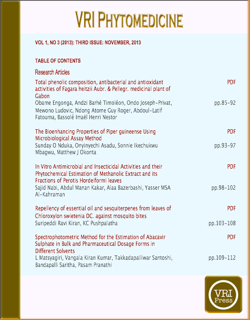
The Bioenhancing Properties of Piper guineense Using Microbiological Assay Method
Abstract
BACKGROUND: Improving the bioavailability of drugs with the use of compounds with bioenhancing properties are currently on the increase. Bioenhancers modulate the activities of drug metabolising enzymes and P-glycoproteins leading to alterations in drugs’ pharmacokinetic properties. The ease of development of resistance to most antibiotics is of serious concern in most parts of the world. This may be attributed to low bioavailability of some of these drugs in vivo resulting in sub-therapeutic concentrations of the drugs reaching the organisms and subsequently resistance development.
OBJECTIVE: This study was designed to determine the bioenhancing properties of Piper guineense leaves extract and determine its effect on the pharmacokinetic properties of pefloxacin using animal model.
METHOD: In vivo studies using microbiological assay method and clinical isolates of E. Coli samples from hospitalized patients were used.
RESULT: There was a significant change (p<0.05) in the area under curve (AUC) of pefloxacin when co-administered with Piper guineense showing about 107.83 % increase from 41.50 µg/hr/ml to 86.25 µg/hr/ml. Similarly, maximal pefloxacin concentration (Cmax) increased from 0.9867.33 µg/ml when pefloxacin was administered alone to 10.00 µg/ml when administered in the presence of the extract with a significant change (p<0.05) in the time to attain maximal concentration. Half life (t1/2) and volume of distribution (Vd) of pefloxacin showed a non-significant increase and decrease respectively, in the presence of the extract.
CONCLUSION: The co-administration of pefloxacin and extract of Piper guineense leaves altered the bioavailability of the drug and could be used to improve the pharmacotherapy of this agent.
Keywords
Full Text:
PDFReferences
Randhawa GK, Kullar JS, Rajkumar: Bioenhancer from mother nature and their applicability in modern medicine. Int J App Basic Med Res 2011; 1:5-10
Chawla PC: Resorine A novel CSIR drug curtails TB treatment. CSIR news 2010; 60:52-4
Janakiraman K, Manavalan R: Studies on effect of piperine on oral bioavailability of ampicillin and norfloxacin. Afr J Tradit Comp Altern Med. 2008;5:257-62.
Patil UK, Singh A, Chakraborty AK: Role of Piperine as a bioavailability enhancer. Int J Recent Adv Pharm Res. 2011; 4:16-23.
Atal N, Bedi KL: Bioenhancers: Revolutionary concept to market.J Ayurveda Integr Med. 2010; 1(2): 96-99.
Rehn S, Espig G: The cultivated Plants of the tropics and subtropics. Cultivation, Economic value, Utilization. Verlag Josef Margraf, Weikersheim, Germany, 1991: 522
Mann A, Amupitan JO, Oyewale AO, Okogun JI, Kolo I: An ethnobotanical survey of indigeneous flora for treating tuberclosis and other respiratory diseases in Niger state, Nigeria. J Phytomed Ther 2007; 12: 1-21.
Ndukwu BC & Ben-Nwadibia NB: Ethnomedicinal aspects of plants used as spices and condiments in Niger Delta. http//:www.opensiuc.lib.siu/cgi/viewcontent. Accesses 07/08/2013.
Okwute SK, Egharevba HO: Piperine-Type Amide: Review of chemical and Biological characteristics. Inter J Chem 2013; 5(4): 99-122.
Moutafchieva R, Kanelov I, Grigorov I: Comparative pharmacokinetics of pefloxacin in chickens, pheasants and pigeons. Trak J Sci 2009;7(1): 44-48,
Montay G, Coueffon Y, Roquet F: Absorption, distribution, Metabolic fate, and Elimination of Pefloxacin in Mice, Rats, Dogs, Monkeys and Humans. Antimicrobi Ag Chemotherap 1985; 25(4): 463-472
Sweetman S. (ed.). Martindale: The complete drug reference. London: Pharmaceutical press, 2005. Electronic version.
Moutafchieva R, Kanelov I, Grigorov I: Comparative pharmacokinetics of pefloxacin in chickens, pheasants and pigeons. Trak J Sci 2009;7(1): 44-48.
Toutain PL, Bousquet-Melou A: Bioavailability and its assessment. J VetPharmacol. Therap. 2004; 27:455-466.
Dudhatra GB, Mody SK, Awale MM: A comprehensive review on pharmacotherapeutics of herbal bioenhancers. Sci World J 2012. Article ID 637953, 33 pages. Doi:10.1100/2012/637953
Varshneya C: Use of herbal Bio-enhancers in animal health care.
Badmaev V, Majeed M, Norkus EP: Piperine, an alkaloid derived from black pepper increases serum response of beta-carotene during 14-days of oral beta-carotene supplementation. Nutri Res 1999; 19(3):381-388.
Pandey K, Raman RP, Kumar K, Pandey KP: Antiparasitic efficacy of piperine against Argulus spp on Carassius auratus (Linn. 1758):in vitro and in vivo study. Parasitol Res 2012; 111(5):2071-2076
Srinivasan K: Black pepper and its pungent principle-Piperine: A review of diverse physiological effects. Critical Reviews food Sci Nutr. 2007; 47(8):735-748.
Mehmood MH, Gilani AH: Phamacological basis for the medicinal use of black pepper and piperine in gastro intestinal tract disorders. J Med Food 2010; 13(5): 1086-1096.
Scott IM, Jensen H, Nicol R: Efficacy of piper (Piperaceae) extracts for control of common home and garden insect pests. J Econos Entomol. 2004; 97(4): 1390-1403.
Fuhr U, Sorgel F, Kinzig SM: Interaction of Pefloxacin and Enoxacin with the human cytochrome P450 enzyme CYP1A2. Clin Pharmacol Therap. 1999
Atal CK, Dubey RK, Singh J: Biochemical basis of enhanced drug bioavailability by piperine: evidence that piperine is a potent inhibitor of drug metabolism. J Pharmacol Exp Thera. 1985; 232(1);258-262.
Dama MS, Varshneya C, Dardi MS, Katoch VC: Effect of trikatu pretreatment on the pharmacokinetics of pefloxacin administered orally in moountain Gaddi goats. J Vet Sci 2008; 9(1): 25-29.
DOI: http://dx.doi.org/10.14259%2Fpm.v1i3.57
Refbacks
- There are currently no refbacks.






